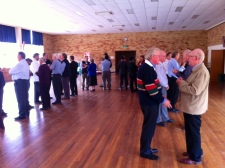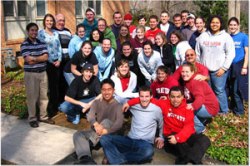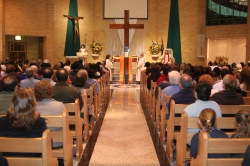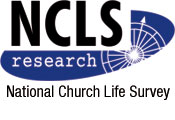 Some 550 delegates from Australia, New Zealand and Papua New Guinea gathered at the Proclaim Conference 2014 this past week in Sydney to listen to leaders in parish ministry and evangelisation.
Some 550 delegates from Australia, New Zealand and Papua New Guinea gathered at the Proclaim Conference 2014 this past week in Sydney to listen to leaders in parish ministry and evangelisation.
These practitioners included the authors of Rebuilt, Fr Michael White and Tom Corcoran, representatives of other Christian denominations, and Catholic lay men and women committed to transforming their local communities.
It was a whirlwind of three days, with almost forty workshops made available and addressing RCIA, faith support for families, the quality of parish leadership, ordained and lay, issues of disability and inclusion in our parishes, liturgical practice, and the use of new media in parishes, among others.
The best aspect of the conference for me was to connect with old and new friends, to experience the solidarity of so many others seeking to live the same mission, and to hear and weigh up the many complex issues that are involving in living what is, at least in principle, if not in practice, a simple and holy mission: to allow the life of the Gospel, the life of Jesus, to radiate within and flow out of the heart of our parish communities into the world that hungers and awaits a Word of life and hope.
I was also privileged to present a workshop at the conference which I share below in the hope it might trigger your own reflections on how you might best lead your parish community into a better future (for more regular readers of this blog, it contains many of the views expressed previously but not yet shared with a wider audience). A PDF of this presentation as well as a resource I handed out – the ideal parish pastoral plan (at least as I imagine it!) – is also available at the end of this blog if it is of help and interest to you.
The Pastoral Reality
 It is fair to say that the parish remains the primary experience of Church for many Catholics. There is much to celebrate – the commitment of our leaders, ordained and lay, various forms of pastoral activity and outreach, the living faith that makes these communities a true spiritual home.
It is fair to say that the parish remains the primary experience of Church for many Catholics. There is much to celebrate – the commitment of our leaders, ordained and lay, various forms of pastoral activity and outreach, the living faith that makes these communities a true spiritual home.
However, we are also conscious of the many challenges that face our parishes. Among these is the decline in the number of those attending these communities on a weekly basis. Indeed, researchers have described the parish as having reached a ‘critical moment’ in the life of the Australian Church.[1]
We know that of our 5.4 million Catholics in Australia only 662,000 or 12.2 per cent join us for Eucharist on any given weekend.[2] Almost a third of these Mass attenders (some 220,000) are aged between 60 and 74 while of all Catholics aged between 20-34 in Australia, only 5-6% attend.[3] So we are witnessing an ageing congregation with fewer among younger generations to replace them as we move into the future.
Migrants, of course, account for over 40% of our Mass attenders.[4] We are indebted to and sustained by the participation of these diverse ethnic communities. However, we also know that second generation Australians, that is, the children of Catholic migrants, are far less likely to practice than their parents.
Furthermore, some 13,000 Catholics stop attending Mass each year, and across all age groups more than 20,000 Australians every year are ceasing to identify themselves as Catholic (a dis-identification of some 100,000 Catholics over the last five years).[5]
 As Dr Bob Dixon, among others, has recognised, the prospect that this situation raises in our lifetime is that of ongoing Catholic institutions, including schools, colleges, universities, hospitals, nursing homes and aged care facilities but fewer parishes where the worship of God enjoins a community of believers.[6] The related concern is that the Church in Australia will be reduced to a form of non-government organisation, a provider of services – including healthcare and education – but whose religious dimension is associated more strongly with their historical origins rather than their existing or ongoing spirit.
As Dr Bob Dixon, among others, has recognised, the prospect that this situation raises in our lifetime is that of ongoing Catholic institutions, including schools, colleges, universities, hospitals, nursing homes and aged care facilities but fewer parishes where the worship of God enjoins a community of believers.[6] The related concern is that the Church in Australia will be reduced to a form of non-government organisation, a provider of services – including healthcare and education – but whose religious dimension is associated more strongly with their historical origins rather than their existing or ongoing spirit.
It becomes clear that we need our Catholic parishes to grow because they are integral and indispensable to our spiritual identity as a Church. Together with the family, the local parish remains the primary venue where faith is given shape and social support, fostered into discipleship and then enters the world, impelled by the Word and Eucharist. In all these ways, the future of the Australian Church relies on the vitality of the local Catholic parish.
The Call to Grow
It is challenging, then, to concede that many of our parishes have few or no plans to grow, have no explicit vision for making disciples, and can assume people are growing and disciples are being made despite evidence to the contrary.
 Indeed, it could be said that we do not often talk about ‘Church growth’ or ‘growing the Church’, apart from the occasional appeal for priestly vocations or in the context of planned giving campaigns. Some would regard talk of ‘Church growth’ as rather bureaucratic or managerial in tone, a language more at home in the Business Review Weekly than the Gospel of Jesus.
Indeed, it could be said that we do not often talk about ‘Church growth’ or ‘growing the Church’, apart from the occasional appeal for priestly vocations or in the context of planned giving campaigns. Some would regard talk of ‘Church growth’ as rather bureaucratic or managerial in tone, a language more at home in the Business Review Weekly than the Gospel of Jesus.
And yet . . . God calls our Church and our parishes to grow. From the commission given to us by Jesus himself, ‘Go . . . and make disciples of all nations, baptising them in the name of the Father, and of the Son and of the Holy Spirit, and teaching them to obey everything that I have commanded you’ (Matt. 28:19-20) to Vatican II which exhorts the Church in Christ, to ‘pray and labour that the entire world may become the People of God’, the call to grow is an essential element of our identity and calling as a Catholic Church and as Catholic parishes.[7]
We have been given a mission of grace (baptising into the life of Christ) and a teaching mission (as 2 Peter 3:12 affirms, to assist our people ‘grow in the knowledge of the Lord’). In other words, we are being asked to go deep and wide.
While this may seem obvious, I propose that many parishes have not made growth in faith and the gaining of new members the explicit goal of their life and ministries, and dangerously only assumed them to be so. Without this clarity of purpose and a deliberate intent to expand, parishes can be resigned to a ‘decent minimum of religious conformity’ awash with verbal formula, exterior practices and too many undigested experiences of Mass and the Church among their members.[8] However, a ‘no growth’ mentality or complacency has its consequences.
When asked, 60% of Australian Mass attenders reported only some or no spiritual growth through their experience of parish life.[9] The very real danger is that when people don’t grow, they begin to question their commitment and some are even tempted to leave. Meanwhile, 72% of Australian Mass attenders reported that they would not or did not know if they would invite someone to their parish.[10] It tells us that not everything we do as parishes makes disciples and, furthermore, when people are not growing they are not able to be witnesses for Christ in the wider community.
So, as a first step towards renewing parish culture we need to reclaim the basic commission of the Gospel to create better disciples and more disciples, both at the same time, ‘adding to our number’ as the Acts of the Apostles would express it (Acts 2:47) and becoming ‘mature in Christ’ (Col. 1:28). If spiritual and numerical growth, growing in and as Church, does not shape the way we do what we do, our communities can become caught in directionless routine with much movement but very little progress. Moreover, without the goal and the expectancy of growth, our parish workers can be caught dangerously between dedication and despair.
 Without the desire to grow and actual plans to bring it about, we end up drawing on the same, small pool of laypersons for parish ministry and service, we struggle with succession in ministries leading to burn out and fatigue of our existing members, we become trapped in a self-affirming culture that neglects our God-given purpose to evangelise, and even risk becoming communities that are content or resigned to grow old rather than move forwards.
Without the desire to grow and actual plans to bring it about, we end up drawing on the same, small pool of laypersons for parish ministry and service, we struggle with succession in ministries leading to burn out and fatigue of our existing members, we become trapped in a self-affirming culture that neglects our God-given purpose to evangelise, and even risk becoming communities that are content or resigned to grow old rather than move forwards.
Hence, growth matters. The point made by the ressourcement theologian Henri de Lubac of the life of the Church in general applies to the life of the parish and its members in particular – interiorisation (the process by which the Gospel penetrates ever more deeply in the Spirit) goes hand in hand with universalisation and evangelisation (an awareness, commitment and outreach to others in that same Spirit).[11] The deepening of our personal life in Christ leads to an expanding capacity to serve others. We are called to grow in both person and community.
Obstacles to Parish Growth
It is a great tradition of our life and liturgy that in seeking to grow we must first name those obstacles that prevent us from growing in discipleship and that limit our outreach to those beyond the pews. There are a number of contradictions that could be named.
Firstly, while our parishes are called to be ‘schools of prayer’ we often assume our people know how to pray when Romans 8:26 reminds us that ‘we do not know how to pray as we ought’.[12] The Gospel reminds us that prayer is taught and learned, just as Jesus teaches his disciples how to pray to the Father, and yet there can be few opportunities to learn the practices and traditions of prayer in everyday life for the people in our pews. There are few prayers for miscarriage, neonatal loss, parent-teen relationships, chronic sickness, life aspirations and personal crises. Parishes can support their people to express their faith and experience in words by teaching and guiding prayer, both personal and communal, support that is not always extended.
We can also assume our parishes are welcoming. However, we can measure this by the relationships between existing members of our communities rather than the experience of the newcomer. When a sense of welcome and belonging to parish is thin, people can fail to graduate from being ‘mere attenders’ to becoming active participants in the mission of God which this community seeks to serve in the world.
 Above all, we can assume that those coming for the sacraments are already, ipso facto, disciples. However, as Sherry Weddell estimates, as little as 5% of our Mass attenders could be described as ‘intentional disciples’, as having made the conscious and personal decision to live as a disciple of Christ as their saviour and Lord.[13] Not all of our Mass attenders have allowed the Gospel to become the overriding, internal authority of their lives.
Above all, we can assume that those coming for the sacraments are already, ipso facto, disciples. However, as Sherry Weddell estimates, as little as 5% of our Mass attenders could be described as ‘intentional disciples’, as having made the conscious and personal decision to live as a disciple of Christ as their saviour and Lord.[13] Not all of our Mass attenders have allowed the Gospel to become the overriding, internal authority of their lives.
It is a curiosity of Catholic culture, as Weddell goes on to note, that those who do openly talk about Jesus and live enthusiastically in relationship to him can be viewed with suspicion, as ‘Protestant’ in spirit or else pretenders to sanctity (as Weddell concludes ‘we don’t know what normal is’).[14]
In terms of fostering intentional discipleship, an obstacle that can stymie the personal growth of people in our pews is an almost exclusive emphasis on the sacraments which, ironically, can obscure the full life to discipleship for which the sacraments exist. Pope Francis notes in Evangelii Gaudium that in many of our parishes ‘an administrative approach prevails over a pastoral approach, as does a concentration on administering the sacraments apart from other forms of evangelisation’.[15]
This aligns well with the insight of Michael White and Tom Corcoran in Rebuilt when they point out:
. . . baptisms, confessions, weddings, funerals, daily devotions, anointing, and adoration. It’s all good stuff, it’s how some Catholics grow spiritually. For others, it’s what they do instead of grow . . . For certain, the sacraments give us grace to put us in right relationship to God and his life in our soul, nourishing and strengthening us for our discipleship walk. But they’re not mean to replace it.[16]
The point being made by Pope Francis and Rebuilt is that people in our parishes can be ‘sacramentalised’ without being evangelised. Sacraments only make sense in the context of a life of discipleship; they can never replace it. The problematic is that if the whole concept of ‘discipleship’ is reduced to liturgy or Mass attendance alone, then even the practice of attending Mass is likely to weaken over the long term as the very point of a sacramental life is lost on those participating.
Sacraments nourish a life of discipleship that already exists, they cannot substitute for it. The grace that the sacraments make present needs to be received by a life of faith, by a ‘positive disposition’ as the Church describes it, within the context of a personal relationship to Jesus that opens the heart and will to conversion in love (indeed, some have questioned whether the Catholic Mass while evangelising in principle is often so in practice on account of the uneven religious literacy of our people and the uneven quality of much liturgical music and preaching).
 On the level of formation, the teaching mission we have received from the Gospel, it is worth noting that the emphasis in parish communities has traditionally fallen on the catechesis of children and youth. Understandable we want young people in our parishes for their vibrancy and energy as well as the tangible hope that they bring. However, we need to acknowledge that young people will not be attracted to parishes or communities that show no energy or dynamism in themselves.
On the level of formation, the teaching mission we have received from the Gospel, it is worth noting that the emphasis in parish communities has traditionally fallen on the catechesis of children and youth. Understandable we want young people in our parishes for their vibrancy and energy as well as the tangible hope that they bring. However, we need to acknowledge that young people will not be attracted to parishes or communities that show no energy or dynamism in themselves.
We need a parish focus on adult formation as adult Catholics witness to younger Catholics what a mature faith looks like and the formation of adults creates a context which supports the life of faith of everyone in the community (as they say ‘a rising tide floats all boats’).[17] If we want to raise the standard of discipleship in the Church then adults who are prayerful, steeped in Scripture, theologically literate, articulate and committed to justice must be the new norm. Only then, in fact, will the faith of young Catholics naturally aspire to more than intergenerational conformism.
When we consider our parishes, the sources of formation for the majority of those who attend can be limited to essentially the parish bulletin, a homily preached well or otherwise, and perhaps the sign value of the sacraments. We are, if we are honest with ourselves, often relying on the fact that new and established members of our Church are simply ‘putting it all together’ by themselves, an optimism that that is not supported by the reality of parish decline. From observation, people are grasping only fragments and from the outside.
Finally, there can be a predominance of insider thinking, ‘Church world’ as the authors of Rebuilt name it.[18] This rather skewed perspective can be signified by the simple practice of advertising Christmas Mass times in local newspapers. While this is a good and proactive endeavour, it is worth remembering that, in terms of evangelisation, people are not staying away from our Masses because they do not know what time they are on. People are not coming to Mass because they do not see any point in doing so, because they don’t see any connection between what the parish might be offering and their life that they are living or aspired to bring about. If we get caught in insider-thinking as parishes, we can fail to see that people are not going to come to our parishes if they have no idea why they should.
Practices of Growth
This leads us neatly from our challenges to our potential. In light of the trends impacting on our parishes with growing intensity, and the present dynamics of some parish cultures, it is evident that if we want to reach people we have never reached before, we have to be prepared to do things we have never done before, and have a new heart for the Great Commissioning to grow the community of God.
One certainty is that parishes do not grow if leaders and parish teams do not want them to. We cannot assume parish and ministry group leaders want to grow their community when there are no specific plans or intentions to do so. It is interesting to note that emotions in a parish can pour out over changes to buildings, Mass times or parish structure but rarely do they pour out over the absence of newcomers from our pews. Perhaps our hearts can be set on stability rather than growth.
I was once asked by a parish pastoral council to name the biggest obstacle to evangelisation. In my view it would be a lack of faith that the Gospel is worth sharing. Parish leaders and ministry groups must have the desire to grow, have a renewed belief in Jesus and his Church so that our parish programs and processes may bear fruit. After all, programs do not make disciples; disciples make disciples. As Paul VI intimated, only an evangelised Church evangelises.[19] Our parishes will grow when their leaders grow in faith, in the hope of possibilities unseen, and in a love that grows through the practice of love. A sign of a leader committed to parish growth will be one committed to their own growth in the spiritual life.
As intimated, few parishes have a clear direction for their life, a clear vision for making disciples. We need to work towards parishes, each with its own clarity of purpose. Without an overarching vision or purpose that is shared and owned by the whole community, it is difficult for groups, ministries and members to be united or collaborate, quite simply because no one has ever asked and no one has asked together ‘Where are we going?’
To make this concrete, we might ask ‘what is the vision of your parish for its life over the next three years?’ Catholic parishes do not often articulate such a vision and yet are surprised that the commitment level is so low. Commitment will always be low when there is no direction, no sense of purpose and aspiration for the community. Note also that a vision cannot simply be put on a noticeboard; a vision has to be explained, shared and talked about time and again, explaining ‘where we are going’ on the basis of where we are.
A vision also enables a community to evaluate itself on its performance. If a parish community clearly understands that ‘evangelisation of unchurched Catholics’ is its priority for the next three years, the parish can then ask questions when that doesn’t happen, and try and be more effective in that area. Without a parish vision or purpose, no questions are ever raised and there is no motivation to change and to grow.
In speaking of the need for inspired leadership and a compelling vision, it will come as no surprise that parish planning is a particular focus of mine and a recommendation in bringing about renewal.
While ‘pastoral planning’ sounds less glamorous than many other aspects of Church life, it is indispensable for communities to cultivate the type of discipleship which we seek as a Church in response to God.
All communities need to make plans because wanting to grow is not enough. We need to plan to grow and be explicitly organised to grow the faith of our members as well as to evangelise. Indeed, church research reveals that making no plans for growth results in little or no growth every time.[20] Without a commitment to planning, church communities and ministries do not grow and, in fact, risk decline. The alternative to a vision for growth, as we have said, is directionless and unresponsive routine.
 When a community has a clear plan, including a vision for where it wants to be in three years’ time, and actions, time frames, and owners of those actions to bring them about, it also becomes possible for parishes to let go of activities and groups that do not make disciples or help them to achieve their goals. Planning reminds a parish that its mission is not to preserve ashes but to keep a fire alive.
When a community has a clear plan, including a vision for where it wants to be in three years’ time, and actions, time frames, and owners of those actions to bring them about, it also becomes possible for parishes to let go of activities and groups that do not make disciples or help them to achieve their goals. Planning reminds a parish that its mission is not to preserve ashes but to keep a fire alive.
In terms of parish evangelisation out of the pews, to the 90% of self-identified Catholics on the margins of our parish life, a first step is to recognise that these ‘unchurched’ Catholics we seek to reach for Christ are not strangers ‘out there’ nor are they statistics without names or faces. The unchurched are in our homes, sitting at the dinner tables of practicing Catholics! They are our relatives, friends, and neighbours who identify as ‘Catholic’ in some way but do not participate in regular worship or intentional acts of Christian service.
It follows that reaching the unchurched is a matter of skilling and empowering practicing Catholics to start the conversation about faith with relatives, friends and neighbours. Unfortunately, as we have noted, resources and practical assistance to prepare our people for this task is rarely found in our parishes.
It is worth noting that some Baptist communities offer workshops to support wives in faith-filled conversations and relationships with their husbands who are often less likely to attend a weekend service. It recognises that evangelisation takes place via the relationships and via the bridges of credibility in our lives. Again, disciples make disciples. We need to form practicing members of our Church to have the confidence in faith, skills and relational sensitivity to reach out to those they know and love with the Good News of the Gospel.
 Another key strategy for growth is small groups and Rebuilt affirms this as a direction for all parishes to consider. It is interesting to note that the National Church Life Survey revealed that Australian Catholics, when asked, valued ‘community life’ as one of the most valued aspects of parish life.
Another key strategy for growth is small groups and Rebuilt affirms this as a direction for all parishes to consider. It is interesting to note that the National Church Life Survey revealed that Australian Catholics, when asked, valued ‘community life’ as one of the most valued aspects of parish life.
However, at the very bottom of this scale was ‘small groups’ and ‘reaching out to others’.[21] And yet, it is precisely by small groups and the invitation of others that most Catholics find their way into the heart of the Church as a community of faith.
Our Catholic masses are often just too large for people to feel instantly at home. Most of us have come into the heart of the Church through a small group of some description, whether that was a youth group, prayer group or other association. Small groups are one way in which people can explore and grow in their faith in the context of a personal and supportive network of disciples.
To make the point a different way, no one knew they needed an iPhone until Steve Jobs invented one. As a Church we are similarly challenged to offer our people the small group they never knew they needed, whether that be a group of prayer and reflection, Scripture study or missionary outreach which develops their personal relationship with Jesus in the midst of others.
Finally, another indispensable measure by which we can focus on the unchurched is to pray that the outreach of the parish will be effective. Prayer brings us to what is most important to us in our life of faith. Praying for the parish mission to be effective, praying that members will reach out to others with joy, praying that relationships will be transformative, places our efforts to evangelise in the heart and hands of God and in the heart and hands of the worshipping community. A parish that is not praying for new members, that does not explicitly name those who the parish is trying to reach for Christ, can be reasonably questioned on the seriousness of its intent.
We can be tempted to feel at times in ministry as if there was not enough time for prayer, but in fact the spiritual tradition tells us that a lack of prayer leads to a lack of time for the things that matter. We need to pray so our hearts desire growth. Once our hearts desire that goal, we will find the time and take the action needed to see our parishes grow in life and measure.
Conclusion
 We have surveyed the pastoral reality and underlined the need of our parishes to grow as the foundation of the Australian Church.
We have surveyed the pastoral reality and underlined the need of our parishes to grow as the foundation of the Australian Church.
We have retrieved the need for parishes to set themselves the goal of actual growth in faith as well as numerical growth in response to Jesus’ commission to the Church. We have seen the consequences of a ‘no growth’ mentality and of assuming our people are becoming disciples by the sacraments alone.
We have affirmed the need for leaders with a heart and vision for growth, parish communities with an explicit and articulated purpose, formation that focuses on and talks about discipleship and conversion, small groups to create the bonds of faith that grow discipleship, and communities that pray for and implore the graces of God in this mission.
As Pope Francis remarks, ‘[God] always invites us to take a step forward, but does not demand a full response if we are not yet ready. He simply asks that we sincerely look at our life and present ourselves honestly before him, and that we be willing to continue to grow, asking from him what we ourselves cannot as yet achieve’.[22]
As parishes we need to look sincerely at our life and be willing to continue to grow, all the while imploring the graces of God. In the light of our reality and in the light of faith, we must desire to make disciples and proclaim boldly that in the face of human needs God has provided a response in the person of Jesus. May we live this mission well in the service of the Gospel and in the service of humankind.
* You can download a PDF of this workshop presentation here. As mentioned, I also offered some thoughts on the content of the ideal parish pastoral plan. You can download the sample parish plan here. With best wishes in your ministry and mission, Daniel
References
[1] Robert Dixon, Stephen Reid and Marilyn Chee, Mass Attendance in Australia: A Critical Moment. A Report Based on the National Count of Attendance, the National Church Life Survey and the Australian Census (Melbourne: ACBC Pastoral Research Office, 2013), 8.
[2] Ibid., 1.
[3] Ibid., 2-3.
[4] Pastoral Research Office E-News Bulletin, ‘Issue 18: Who goes to Mass? – First results from the 2011 NCLS – 2 December 2012’. Available online at http://www.pro.catholic.org.au/pdf/ACBC%20PRO%20E-News%20Bulletin%2018.pdf. Accessed 4 August, 2014.
[5] Dixon, Reid and Chee, Mass Attendance in Australia: A Critical Moment, 4; Robert Dixon and Stephen Reid, ‘The Contemporary Catholic Community: A View from the 2011 Census’, Australasian Catholic Record 90/2 (2013): 144-146.
[6] Dr Robert Dixon, ‘The Catholic Community in Australia: Context and Challenges’, Presentation at the Pastoral Research Office Conference: ‘Beliefs and Practices of Australian Catholics’, 20 February, 2014.
[7] Lumen Gentium 17.
[8] Thomas Merton, Inner Experience: Notes on Contemplation (London: SPCK, 2003), 2.
[9] NCLS Research, Denominational Church Life Profile: The Catholic Church in Australia. A Report from the 2011 National Church Life Survey (Strathfield: NCLS Research, 2013), 10.
[10] Ibid., 17.
[11] Henri de Lubac, ‘Christian Explanation of our Times’ in Theology in History, translated by Anne Englund Nash (San Francisco: Ignatius Press, 1996), 452.
[12] John Paul II, Novo Millennio Ineunte 33.
[13] Sherry A. Weddell, Forming Intentional Disciples: The Path to Knowing and Following Jesus (Huntington, Indiana: Our Sunday Visitor, 2012), 62.
[14] Ibid., 49.
[15] Pope Francis, Evangelii Gaudium 63.
[16] Michael White and Tom Corcoran, Rebuilt: The Story of a Catholic Parish (Notre Dame, Indiana: Ave Maria Press, 2013), 77.
[17] Cf. Jane Regan, Toward an Adult Church: A Vision of Faith Formation (Chicago: Loyola Press, 2002).
[18] White and Corcoran, Rebuilt, 43.
[19] Paul VI, Evangelii Nuntiandi 15.
[20] See Ed Stetzer and Mike Dobson, Comeback Churches: How 300 Churches Turned Around and Yours Can Too (Nashville: B&H, 2007), 71–2.
[21] Dr Claudia Mollidor, ‘Parish Life – Who’s Involved and Why?’, Presentation at the Pastoral Research Office Conference: ‘Beliefs and Practices of Australian Catholics’, 20 February, 2014.
[22] Pope Francis, Evangelii Gaudium 153.















